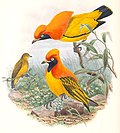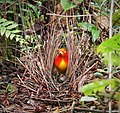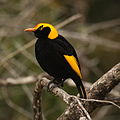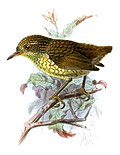| Sericulus | |
|---|---|
 | |
| Regent bowerbird (Sericulus chrysocephalus) | |
| Scientific classification | |
| Kingdom: | Animalia |
| Phylum: | Chordata |
| Class: | Aves |
| Order: | Passeriformes |
| Family: | Ptilonorhynchidae |
| Genus: | Sericulus Swainson, 1825 |
| Type species | |
| Meliphaga chrysocephalus Lewin, 1808 | |
Sericulus is a genus of brightly coloured passerine birds belonging to the bowerbird family Ptilonorhynchidae. They are found in New Guinea and eastern Australia.
Contents
Birds in this genus build "avenue-type" bowers which consist of two parallel walls made of vertical sticks and pieces of grass. [1]



